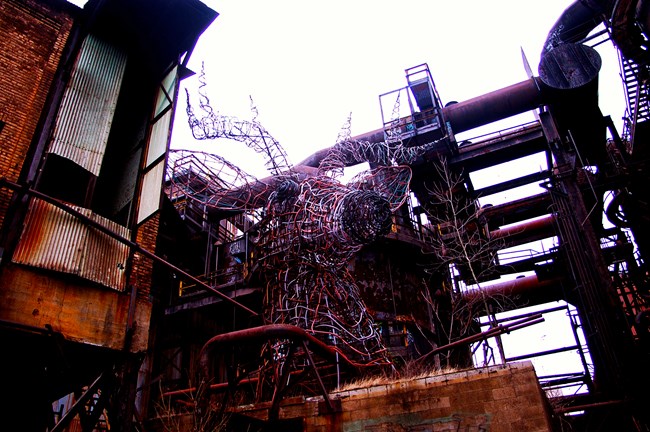Last updated: July 27, 2020
Article
Rivers of Steel Makes Way for New Creations in Old Sites of Industry
Pittsburgh, PA (June 26, 2020) –
Earlier this month, Rivers of Steel National Heritage Area reopened the Carrie Blast Furnaces, the National Historic Landmark that was once part of the massive Homestead Steel Works. The NHA is offering new, safer ways for visitors to get outside and enjoy the historic site without putting themselves at risk. Visitors must register for tours in advance and abide by the local COVID-19 prevention rules to see the industrial landmark’s iron-making facility. Once on-site people can learn about the culture and lives of ironworkers, and get a glimpse of renowned industrial artwork associated with the site.
Earlier this month, Rivers of Steel National Heritage Area reopened the Carrie Blast Furnaces, the National Historic Landmark that was once part of the massive Homestead Steel Works. The NHA is offering new, safer ways for visitors to get outside and enjoy the historic site without putting themselves at risk. Visitors must register for tours in advance and abide by the local COVID-19 prevention rules to see the industrial landmark’s iron-making facility. Once on-site people can learn about the culture and lives of ironworkers, and get a glimpse of renowned industrial artwork associated with the site.

Flickr User "heck, j g"

Rivers of Steel National Heritage Area
Graffiti murals often become iconic in major cities, even when they may have been painted on buildings without the owner’s permission, and this artwork becomes widely accepted by the surrounding communities. In some cities, Dr. Bruce writes, there exist designated “permission walls” where people can express themselves through the art. This is especially important, Bruce says, in communities where low-income, at-risk youth need safe places to express who they are. Instead of attempting to contain and control this creativity, Bruce says, communities can empower young voices and embrace the fresh perspective they bring to old spaces. This also can often deter illegal graffiti. That’s why Bruce’s Urban Arts Project partnered with Rivers of Steel to create the Graffiti Arts Program. GAP empowers youth to express themselves and transform forgotten, underutilized sites into refreshingly creative works of art. In this way, GAP both beautifies its community and brings it closer together.

Rivers of Steel National Heritage Area
